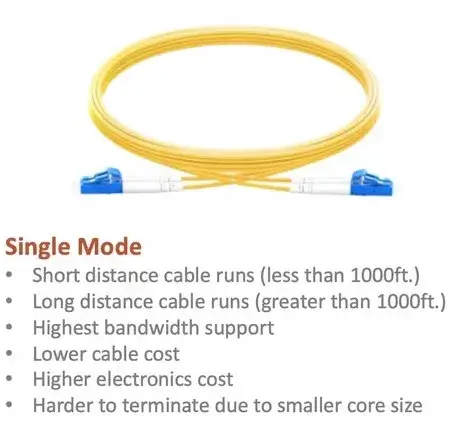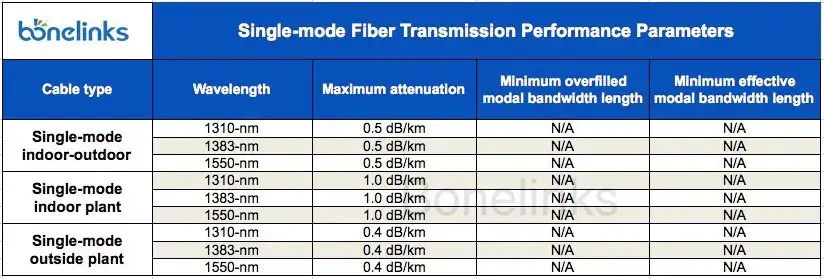What is Single Mode Fiber?
Single mode fiber (SMF), also known as monomode fiber, is a specialized optical fiber technology designed to transmit a solitary ray or mode of light at any given time. This type of optical fiber typically features a slender core with a diameter ranging from 8 to 10µm (micrometers), enabling propagation at wavelengths such as 1310nm and 1550nm. Unlike its multi-mode counterparts, where light rays can take various paths, a single mode fiber ensures that signals follow a direct path down the fiber’s core without bouncing off its edges. This characteristic eliminates distortions that could arise from the overlap of light pulses.
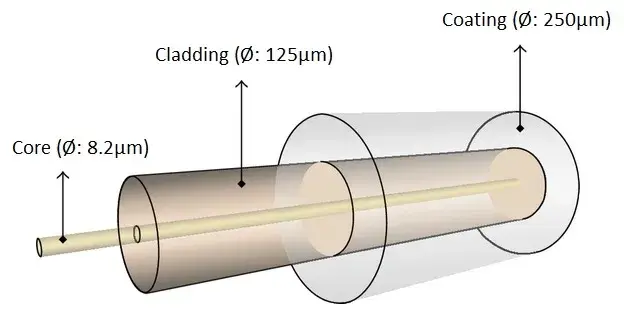
Applications such as Cable TV, Internet, and telephone services commonly utilize single mode fibers. These fibers are often bundled together into larger groups. The primary advantage of single mode optical fibers lies in their ability to transmit data across substantial distances, such as 100 km (60 miles), with minimal signal attenuation due to the use of a solitary light mode.
Single Mode Fiber Types: OS1 vs OS2
As commonly recognized, multimode fiber finds classification in OM1, OM2, OM3, OM4, and OM5 variants. Similarly, within the domain of single mode fiber, we encounter the specifications of OS1 and OS2 fibers.
OS1 fiber finds its primary utility in indoor setups, catering to applications like campus networks and building networks, where the range typically extends up to 10 km. On the other hand, OS2 fiber is better suited for outdoor contexts, encompassing applications such as backhaul networks, external plants, FTTH (Fiber to the Home), and WDM/DWDM networks. In these outdoor scenarios, OS2 fiber showcases its capability by accommodating distances of up to 200 km.
OS1 vs OS2 Single Mode Fiber: What are Their Differences?
Understanding the differences between OS1 and OS2 holds substantial importance during deployment. The specification figure below serves to clearly outline the distinctions existing between these two variants.
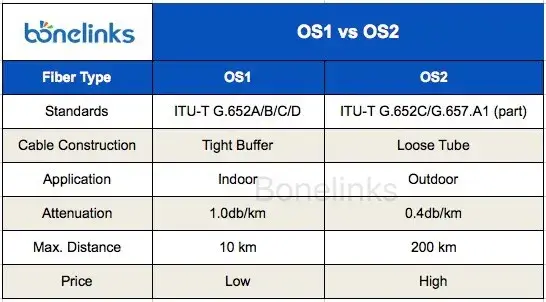
What Are the Advantages and Disadvantages of Single Mode Fiber?
Advantages of Single Mode Fiber
- Distance: Single mode fiber surpasses multimode fiber in terms of distance support due to its lower attenuation. For instance, while multimode fiber typically covers distances of several hundred meters, single mode fiber can achieve potential spans of up to 200 km.
- Bandwidth capacity: A single mode optical fiber cable exhibits superior bandwidth capacity when compared to a multimode fiber optic cable.

- Data dispersion: Single mode fiber exclusively propagates a single mode of light, thereby eliminating any modal dispersion.
- Speed: Single mode fiber is immune to modal dispersion, modal noise, and other phenomena associated with multimode transmission. As a result, it can effectively transmit signals at significantly higher speeds and over distances up to 50 times greater than those possible with multimode fiber.
Disadvantages of Single Mode Fiber
- Stringent Tolerances Required: Coupling light into a single mode fiber presents greater challenges compared to multimode fiber due to the smaller diameter of the fiber core within SMF. The diminutive cores (8-10 µm) demand much tighter tolerances compared to the coupling of light into the larger cores (62.5/50 µm) of multimode fibers.
- Higher Costs Involved: Components and equipment for single mode fiber entail higher costs in contrast to their multimode counterparts. While multimode fiber can accommodate multiple light modes, its cost remains elevated in comparison to single mode fiber. However, at the device level, single mode fiber devices are pricier than their multimode counterparts due to the utilization of solid-state laser diodes in single mode fiber setups.
- Rigorous Technological Demands: The manufacturing and handling of SMFs pose greater complexity compared to MMFs.
ITU Standards for Single-mode Fibers
In order to streamline fiber optic communications, the International Telecommunications Union (ITU) has developed a range of standards pertaining to various optical fiber categories. Presented below is a partial compilation of the principal standards for single-mode fibers.
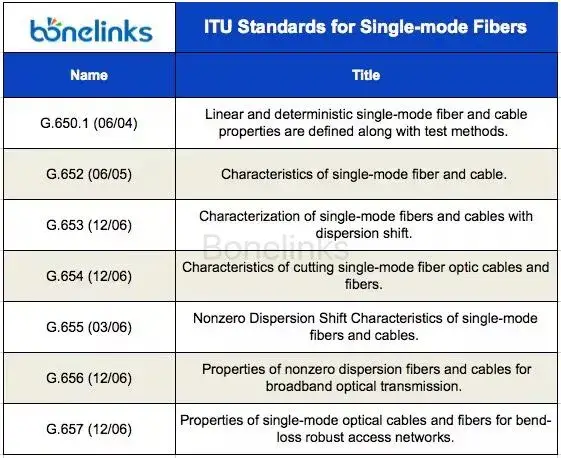
Applications of Single Mode Fiber Optic Cables
Single mode cables find prominent utility in various applications where the requirement revolves around employing a single cable for transmitting multiple frequencies through WDM (Wave-Division-Multiplexing). These applications include:
- Local area networks (LANs) and point-to-point links within urban environments.
- Connections spanning one or multiple buildings.
- Catering to the communication needs of small and medium-sized businesses.
- Serving as the communication backbone within college campuses.
Furthermore, the adaptability of single mode fiber extends to the realm of fiber optic component and equipment production. This encompasses the creation of diverse components like single mode fiber optic adapters, fiber optic attenuators, pigtails, and patch cords. To illustrate, indoor single mode fiber cables can be transformed into fiber pigtails or patch cords, enabling seamless connectivity with single mode fiber optic equipment.
Summary
Considering the factors discussed above, single mode fiber emerges as an essential and efficient component for constructing networks across various scenarios. Its utilization becomes paramount due to its ability to counteract modal dispersion, especially over extended distances. As a result, the adoption of single mode fiber optic cables becomes a preferred solution, particularly for establishing backbone systems.

